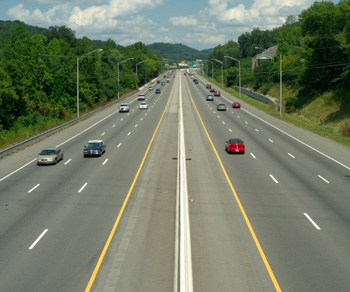
Next to the lowly signal light, which I wrote about last week, another road safety rule that so many people abuse is the correct way to change or enter a lane.
The lines or road markings are there for a reason! They may be solid, broken, white or yellow. Each of those specific characteristics communicates a rule and helps a driver with guidance, car positioning, traffic control and warnings.
All of the rules are outlined in the The Manual of Standard Traffic Signs & Pavement Markings published by the BC Ministry of Transportation. There are a lot of rules related to road markings, but here are a few key road markings that can help ensure safe and courteous driving behavior.
White lane lines
- Delineate the separation of traffic flow in the same direction.
- Mark the outside edge of the right lane.
Yellow directional dividing lines
- Delineate the separation of traffic travelling in opposite directions.
- Mark the left edge line of divided highways and one-way roads.
- Mark both sides of two-way left turn lanes.
White Dotted
- Usually on the left side, these indicate you can cross this line if safe to do so, such as merging onto a freeway.
White solid
- Can be on right or left side of the lane and indicates lane lines or edge lines and restricted lanes such as bus or HOV.
Yellow broken
- Used as guiding lines (ie. Left hand turn lanes)
Yellow solid or yellow solid double
- delineates the separation of traffic in opposite directions and prohibits passing.
Yellow simultaneous solid and broken
- permits passing on the broken side when safe to do so.
Here are the three main rules that are broken by countless people everyday. Not only is it frustrating to other drivers, it is a safety issue. If you can contribute just one better driving habit (next to using your signal lights), follow the road markings rules.
1. Turning across a solid yellow line
Used to prevent unsafe left-hand turns and for traffic control. Please don’t try to cross a solid yellow line, especially on a left turn. Solution – circle the block and come to your destination from the other direction.
2. Turning from an inside lane to an outside lane or vice versa
When turning either right or left through an intersection, take the closest lane or the one that corresponds with your lane. This will be indicated by white dotted lines around the corner. When you turn, stay in the middle of the lane and turn your wheels sharply before advancing, placing your car in the centre of the nearest lane.
Proceed to change additional lanes only after the turn has been executed.
3. Merging
The courteous and proper way to ensure smooth traffic flow is to give and take one car at a time from right to left. Not allowing a car to merge creates a traffic jam, slowing down traffic behind you. It is also unsafe, as the expected driving behavior is to let the other driver in.
Take the time to pay attention to road markings and be a courteous driver to others on the road.
Vote now:
[polldaddy poll=5552646]










